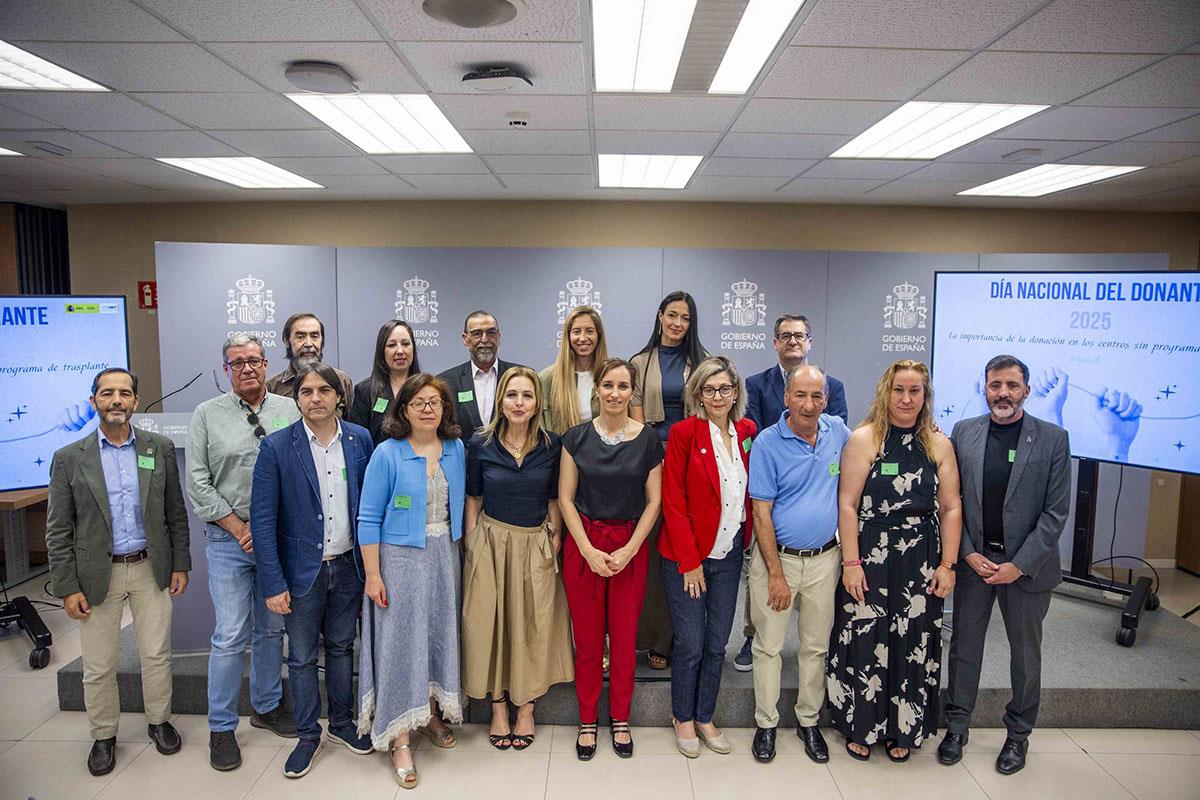 The Minister for Health, Mónica García, at the National Donor Day celebration
The Minister for Health, Mónica García, at the National Donor Day celebration
The Ministry of Health and the National Transplant Organisation (ONT) have once again come together to celebrate National Donor Day, which is organised on the first Wednesday of every June. The aim of this day is to pay tribute to donors and their families and to remember the importance of organ, tissue and cell donation.
To this end, the Minister for Health, Mónica García, accompanied by the Director General of the ONT, Beatriz Domínguez-Gil, presided over an institutional event at the headquarters of the Ministry of Health, which brought together representatives of the organisations that make up the Union of Solid Organ Transplant Patients - the National Federation of Associations for the Fight against Kidney Diseases, the National Federation of Liver Patients and Transplant Patients, the Spanish Federation of Cystic Fibrosis, the Spanish Federation of Heart Transplant Patients, and transplant coordinators and relatives of donors.
This is a great occasion to take stock of the achievements in this area in our country. In this regard, the growth in organ donation activity has been an outstanding milestone. While in 2014, 1,682 people donated their organs after death, just ten years later there were 2,562 donors, an increase of 52%. In this decade, 23,064 people donated their organs. According to ONT, thanks to this act of generosity, from 2014 until last year, 52,634 transplants were performed.
As on other occasions, the ONT selected a specific aspect of the national programme for this day, namely organ donation in hospitals that do not have a transplant programme. The work of the transplant coordinators in these hospitals has been essential for the growth experienced in the last decade, with 8,821 people donating organs in these centres in the last ten years, representing 38% of the total. These donors have made 20,040 transplants possible (compared to 32,594 in hospitals with a transplant programme), including 11,806 kidney, 5,058 liver, 1,794 lung, 1,076 heart, 293 pancreas and 13 intestinal transplants (on 10 occasions combined with other abdominal organs).
In these 145 hospitals across Spain, transplant coordinators identify potential donors, interview and support their families during the grieving and decision-making process, and coordinate, with the support of the ONT, the entire organ and tissue donation operation. However, because it does not have a transplant programme, its work ends with the transfer of organs to transplant hospitals where they are implanted in patients on the waiting list.
Nearly double the number of donors in a decade in non-transplant centres
With regard to the evolution in the activity of these hospitals without a transplant programme, the number of registered donors went from 598 in 2014 to 967 last year, representing a 62% growth. Of the 8,821 donations in non-transplantation hospitals in the last decade, 119 (1%) took place in privately owned hospitals.
The donor profile in these centres differs slightly from that in transplantation hospitals. According to ONT data, the donor in the hospital with a transplant programme is slightly younger, with an average age of 59 years, compared to 62 years in the non-transplant centre. In terms of causes of death, stroke is the most common (63%) in hospitals without a transplantation programme. This is a slightly higher percentage than in centres that do perform transplantation (57%). Traumatic brain injury as a cause of death is less frequent in the non-transplant hospital (12%) than in the hospital with a transplantation programme (15%).
The Minister for Health, Mónica García, recognised the work of non-transplant donor hospitals, which she considers "essential to the high level of donation and transplant activity in our country. Without this, many people would not have the opportunity to become donors at the end of their lives, nor would many patients get that second chance at transplantation". Minister García acknowledged in particular "the great work of the health professionals who take part in these processes and who have contributed to the extraordinary and continuous growth in the number of donors and transplants over the last decade".
The minister highlighted "the generosity of donors and of the families who, at the tragic moment of the loss of a loved one, say yes to donation. This act of homage is for them".
The role of detection hospitals
This network is joined by hospitals that are not authorised for organ procurement, but identify opportunities for donation. After informing the family and obtaining consent, they organise the transfer of the potential donor to an authorised hospital so that the donation can take place. According to ONT data, of all the donors registered in this decade, 390 were transferred from a detector hospital to make the donation effective in another centre. Of these, 249 were transferred from a public hospital and 141 from a private hospital. In 2024 the number of transfers was particularly high with 59 cases, compared to 31 in 2014.
Activity by hospital
The ten non-transplant centres with the highest organ donation activity in the last decade were:
Non official translation




